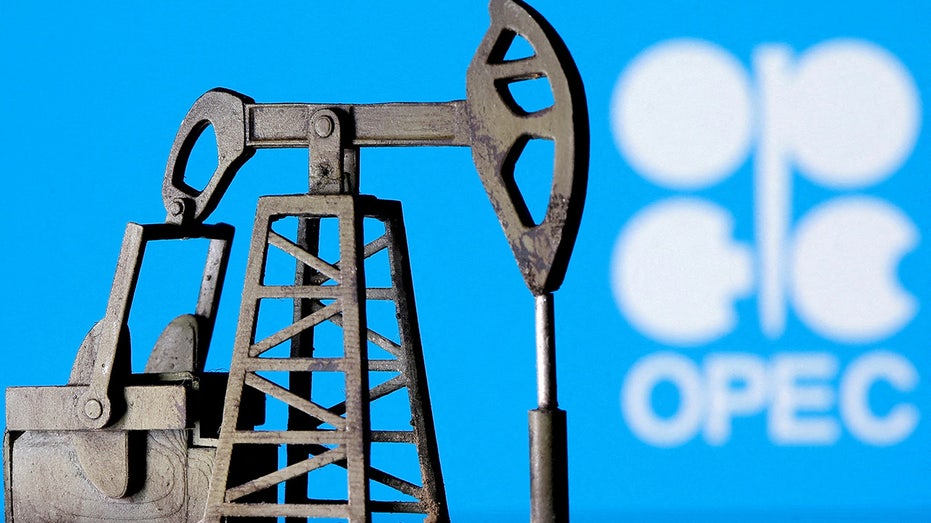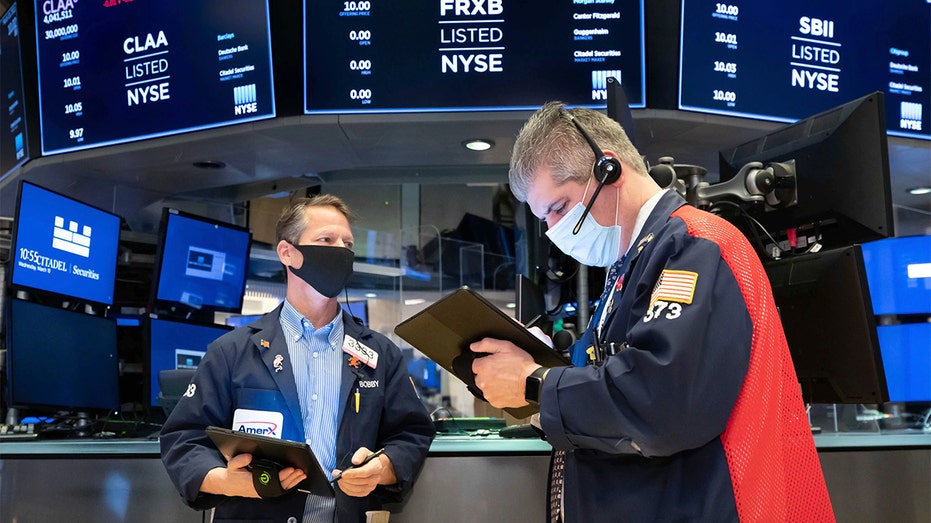OPEC+ considers production cut, Tesla sales lower and more: Monday's 5 things to know
Oil cartel to meet Wednesday in Vienna to consider cutting output by 1 million barrels as Tesla falls short of Wall Street delivery estimates
FOX Business Flash top headlines for September 30
Check out what's clicking on FoxBusiness.com
Here are the key events taking place on Monday that could impact trading.
POSSIBLE OIL PRODUCTION CUT: OPEC+ is meeting this week to decide on production.
The group of oil producers will reportedly consider cutting output by more than 1 million barrels a day, delegates tell Bloomberg.
The meeting will take place on Wednesday in Vienna.
EXXON CEO WARNS BIDEN ADMINISTRATION AGAINST LIMITING FUEL EXPORTS

A 3D-printed oil pump jack is seen in front of the OPEC logo in this illustration picture, April 14, 2020. (REUTERS/Dado Ruvic/File Photo / Reuters Photos)
A production cut would reflect the concern that the global economy is slowing fast in the face of rapidly tightening monetary policy.
Oil prices have also been affected by the stronger dollar.
A final decision on the size of the cuts won’t be made until ministers meet, the delegates said.
Brent crude soared above $125 a barrel following Russia’s invasion of Ukraine in February.
It has since dropped to $85, cutting into the profits that Saudi Arabia, Russia, the United Arab Emirates and other members of the coalition have enjoyed.
Oil prices dipped on Friday in choppy trading but notched their first weekly gain in five on Friday.
TESLA SALES: Tesla’s Q3 sales of its cars and SUVs broke records as the company's factory in Shanghai got past pandemic-related supply chain issues but still fell far short of expectations
The electric vehicle and solar panel company said Sunday it sold 343,830 cars and SUVs in the third quarter, compared with the 254,695 deliveries it made from April through June.
Still, the delivery numbers were short of Wall Street estimates. Analysts polled by data provider FactSet expected sales of 371,000 vehicles.
Tesla said it's becoming more challenging to find transportation capacity at a reasonable cost when it needs to move vehicles from its factories to its customers. Tesla said it had higher than usual numbers of vehicles in transit at the end of the quarter that will count as sales once they're delivered to customers.
TESLA’S ELON MUSK SHOWS OF HUMANOID ROBOT ‘OPTIMUS’ PROTOTYPE WITH EXPECTED $20K PRICE TAG

In this Feb. 2, 2020, file photo, the company logo appears on an unsold 2020 Model X at a Tesla dealership in Littleton, Colo. (AP Photo/David Zalubowski, File / AP Newsroom)
Tesla said it produced 365,923 vehicles in the July-September period. So far this year, the company has delivered 908,573 vehicles, but it will need a strong finish to the year to hit its predictions of 50% annual sales growth for the next few years.
Last year, Tesla delivered 936,172 vehicles. A 50% increase would be just over 1.4 million for this year.
Automakers, including Tesla, have had difficulty getting computer chips and other parts needed to make vehicles. Consequently, many factories are running under capacity, supplies of vehicles are low and prices are high.
ECONOMIC TALE OF THE TAPE: At 10 a.m. ET Monday, a key economic report on U.S. manufacturing activity will be released – the ISM’s manufacturing purchasing managers index for September.
Early indications are expected to show a slip for the third month in a row to 52.2, the lowest since May 2020. It would also mark the sixth month in the last seven of flat or declining manufacturing activity.
For context, the March 2021 reading of 63.7 marked the fastest pace of expansion in more than 37 years (50 is the dividing line between an expanding and contracting manufacturing sector).
Investors should brace for a negative surprise after the Chicago PMI for September, released Friday morning, fell unexpectedly into contraction territory.

Workers erect a building under construction in Philadelphia. (Associated Press / AP Images)
The markets will pay close attention to the prices paid component. It’s expected to fall for the sixth straight month to 51.9. That would be the lowest since June 2020 and offer a glimmer of hope that inflation has peaked, especially after core PCE, a key inflation gauge that excludes food and energy costs, rose a hotter-than-expected 4.9% annually in August, up from 4.7% the prior month.
For perspective, the June 2021 reading of 92.1 was a record high the ISM prices paid index.
At the same time, watch for construction spending to fall 0.3% month-over-month in August, following a 0.4% slide the prior month. It would mark the third consecutive decline, the most since December 2018.
FED'S PREFERRED INFLATION GAUGE ACCELERATED MORE THAN EXPECTED IN AUGUST
MARKETS LOWER FOR WEEK, QUARTER: U.S. stocks fell Friday, closing out a losing week, month and quarter as investors wrestled with more signs of persistently high inflation.
Major indexes have sustained deep losses this year as the Federal Reserve raises interest rates in an attempt to tame rising prices.
The S&P 500, Dow Jones Industrial Average and Nasdaq Composite on Friday all recorded their worst first nine months of a calendar year since 2002, according to Dow Jones Market Data.
Stocks had rallied for two months beginning in June as investors hoped that inflation would cool and the Fed would pull back on its aggressive rate increases. But price pressures have remained stubbornly high, and Fed officials made clear that the monetary tightening would continue.

U.S. stocks were lower last week, last month and for the quarter, which ended of Friday. (Fox News)
Last week, the central bank unveiled another supersize rate increase and signaled that additional large rate raises were likely. The final week of the quarter saw stocks reach new lows in volatile trading.
The Dow Jones Industrial Average on Monday fell into a bear market, a decline of 20% or more from a recent high. Wednesday brought some relief, but only briefly.
Government bond yields dropped after the Bank of England intervened to calm debt markets disturbed by a tax-cut plan, making stocks more attractive to many money managers. But shares tumbled again on Thursday.
| Ticker | Security | Last | Change | Change % |
|---|---|---|---|---|
| I:DJI | DOW JONES AVERAGES | 48134.89 | +183.04 | +0.38% |
| SP500 | S&P 500 | 6834.5 | +59.74 | +0.88% |
| I:COMP | NASDAQ COMPOSITE INDEX | 23307.620391 | +301.26 | +1.31% |
On Friday, major indexes locked in their quarterly losses with another down day. The S&P 500 fell 54.85 points, or 1.5%, to 3585.62. The Dow Jones Industrial Average dropped 500.10 points, or 1.7%, to 28725.51. The Nasdaq Composite declined 161.89 points, or 1.5%, to 10575.62. All three indexes ended at their lowest closing levels since 2020.
The Dow Jones Industrial Average is down 21% in 2022, the S&P 500 is off 25% and the tech-heavy Nasdaq Composite has slumped 32%.
With the central bank signaling it is committed to bring inflation under control, investors have grown fearful that its campaign of rate increases will meaningfully slow the economy.
"In the trade-off between growth and inflation, the Fed is going to choose inflation," said Desmond Lawrence, senior investment strategist at State Street Global Advisors. "That's what's really giving you the choppiness that we've had in the past week in particular."
All three indexes fell for a third consecutive quarter.
For the S&P 500 and Nasdaq, it was the longest quarterly losing streak since streaks ending in March 2009, according to Dow Jones Market Data. The final day of the quarter brought more evidence of the price pressures that the Fed is trying to contain. A measure of inflation that excludes volatile food and energy costs rose to a 4.9% year-over-year increase from 4.7% the prior month, according to the Commerce Department.
CLICK HERE TO READ MORE ON FOX BUSINESS
BONDS HIGHER: Government bond yields continued their march higher.
The yield on the benchmark 10-year U.S. Treasury note has risen this year to 3.802%, from 1.496% on Dec. 31. It ticked up Friday from 3.747% on Thursday.
Yields rise as bond prices fall, leaving investment portfolios battered this year by the dual drawdowns in stocks and bonds.
"It's not so much that we don't get bear markets in stocks," said Lisa Shalett, chief investment officer at Morgan Stanley Wealth Management. "What's made it extraordinary is that there's been no place to hide."




















